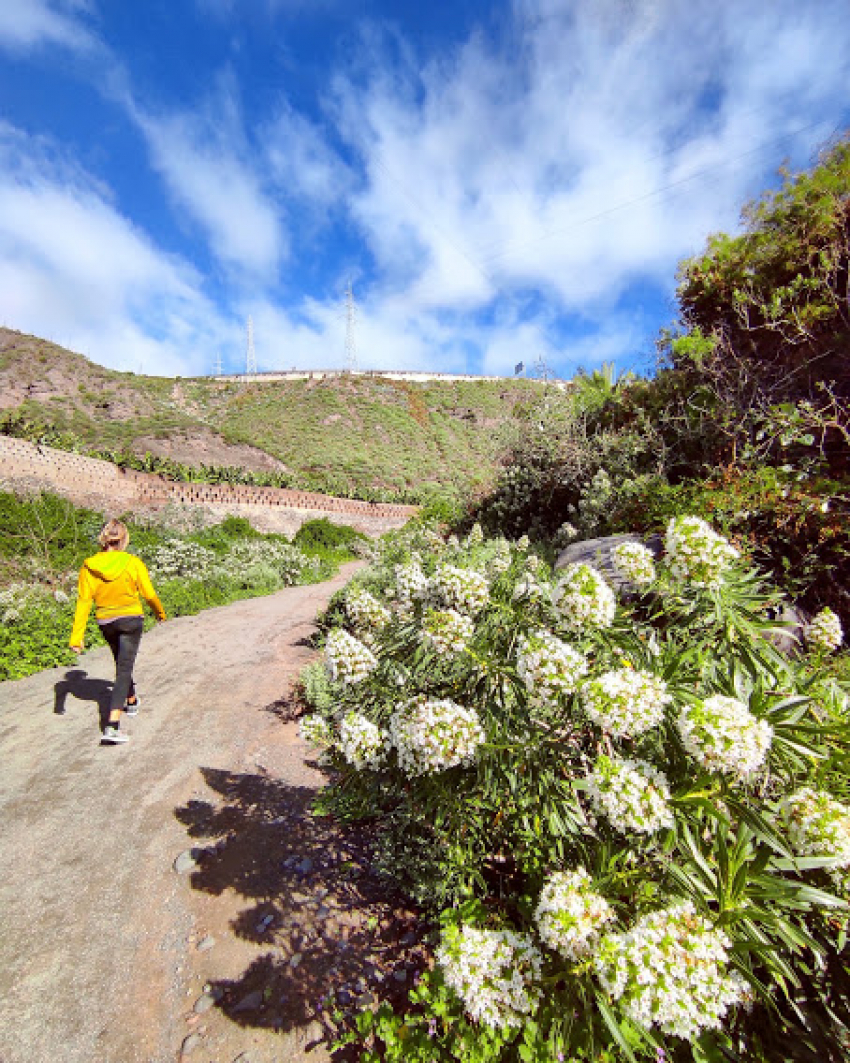Alex Bramwell
The Alis Bar At The Santa Catalina Hotel: Too Trendy To Be Fun
The Alis Bar on the rooftop of the Royal Hideaway Santa Catalina Hotel in Las Palmas is intentionally but achingly trendy but doesn't really have that much atmosphere. It feels like the kid of place people go to look at each other's Gucci trainers rather than to have fun.
It's decorated in a sparse, modern sytle with stripey mock-wood planks, the standard white outdoor furniture, lounger beds, etc. The staff are easy on the eye but not in much of a rush and the drinks are, as you would expect from a 5-Star Hotel Bar, quite pricey for Las Palmas. Think 6 euros for a bottle of 1906 beer and double figures for cocktails.
We hope that the Alis bar turns down the trendy a little over time and becomes somewhere that you'd actually want to spend some time. The location and the view deserve a little more that it offers at the moment. We think that if you want a hotel rooftop bar experience in Las Palmas, both the Bex design Hotel amd the Aloe Hotel offer a better experience.
You Have To Thai This New Place
 We found a small and informal but delicious Thai restaurant in Playa del Inglés and we think everyone should try it.
We found a small and informal but delicious Thai restaurant in Playa del Inglés and we think everyone should try it.
Sawadee in San Agustín, and soon also in Meloneras where the outdoor cinema used to be, is a great Thai restaurant but it is also quite big and even over the top. It's almost like eating in a Thailand theme park. Fun definitely, but not really what we associate with authentic Thai food.
The best we've eaten has always been at a roadside restaurant, often cooked on a tin sheet, or in a family-run restaurant by the beach. Ok, so they have a few flashing lights and maybe even an electric flamingo; but not a whole flock!
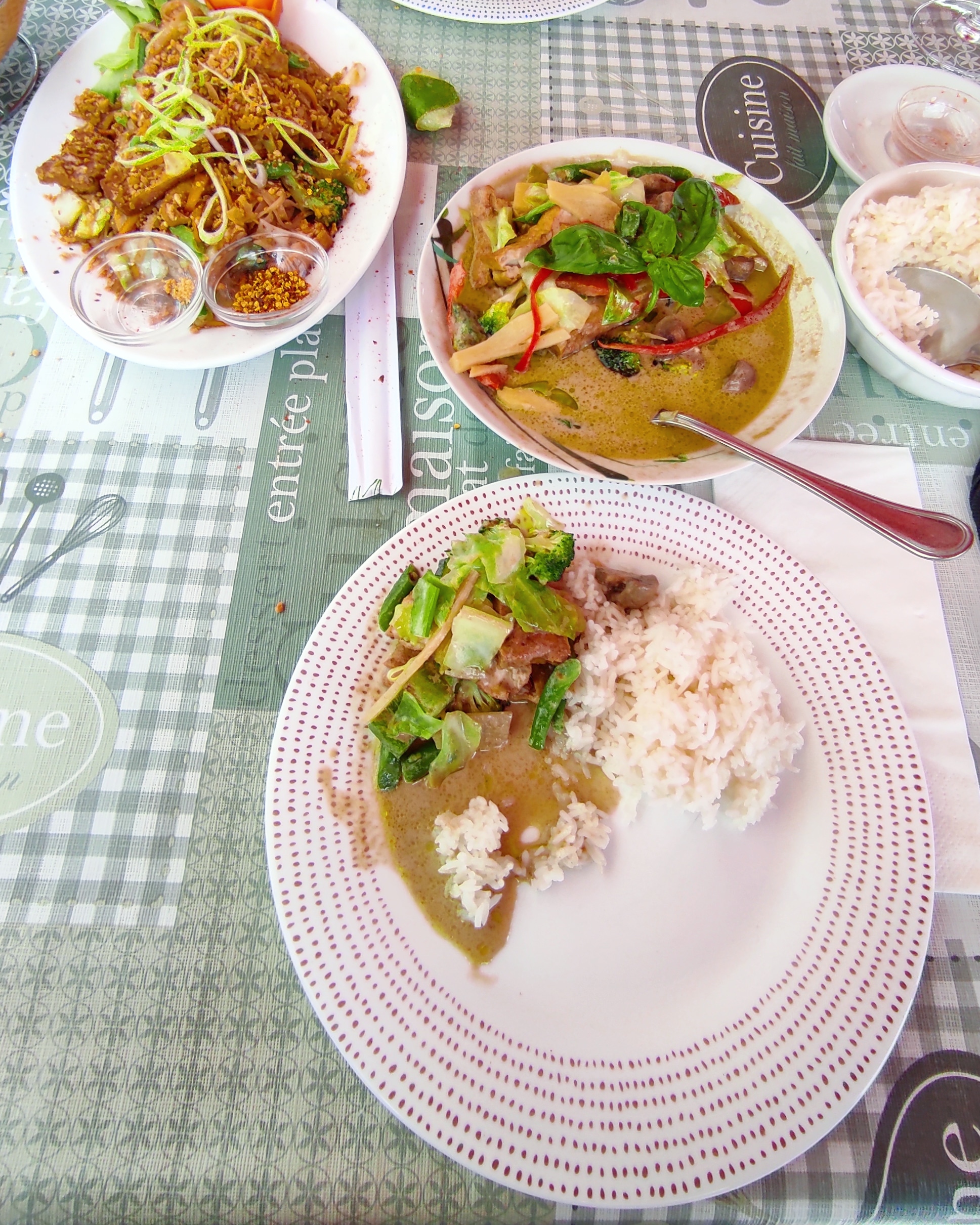 So while we approve of the Sawadees, we were really excited to find that the Thai Bangkok Street Food restaurant does really good, authentic Thai food.
So while we approve of the Sawadees, we were really excited to find that the Thai Bangkok Street Food restaurant does really good, authentic Thai food.
This little place, at the back of Playa del Inglés at the bottom of Apartamentos Los Molinos (no longer rough and ready), is basically a standard Spanish cafe with outdoor tables. There's no airs and graces at all.
However, the food is clearly made by a Thai cook who knows her stuff and is spot on. We had the Pad Thai and Green curry and both were tasty and spicy with the right balance of Thai flavours.
 If you can do Pad Thai right, you can pretty much do the rest so we are more than happy to recommend this place to everyone.
If you can do Pad Thai right, you can pretty much do the rest so we are more than happy to recommend this place to everyone.
We'll be going back soon to get the whole story about how the Thai Bangkok Street Food and to try the rest of the menu.
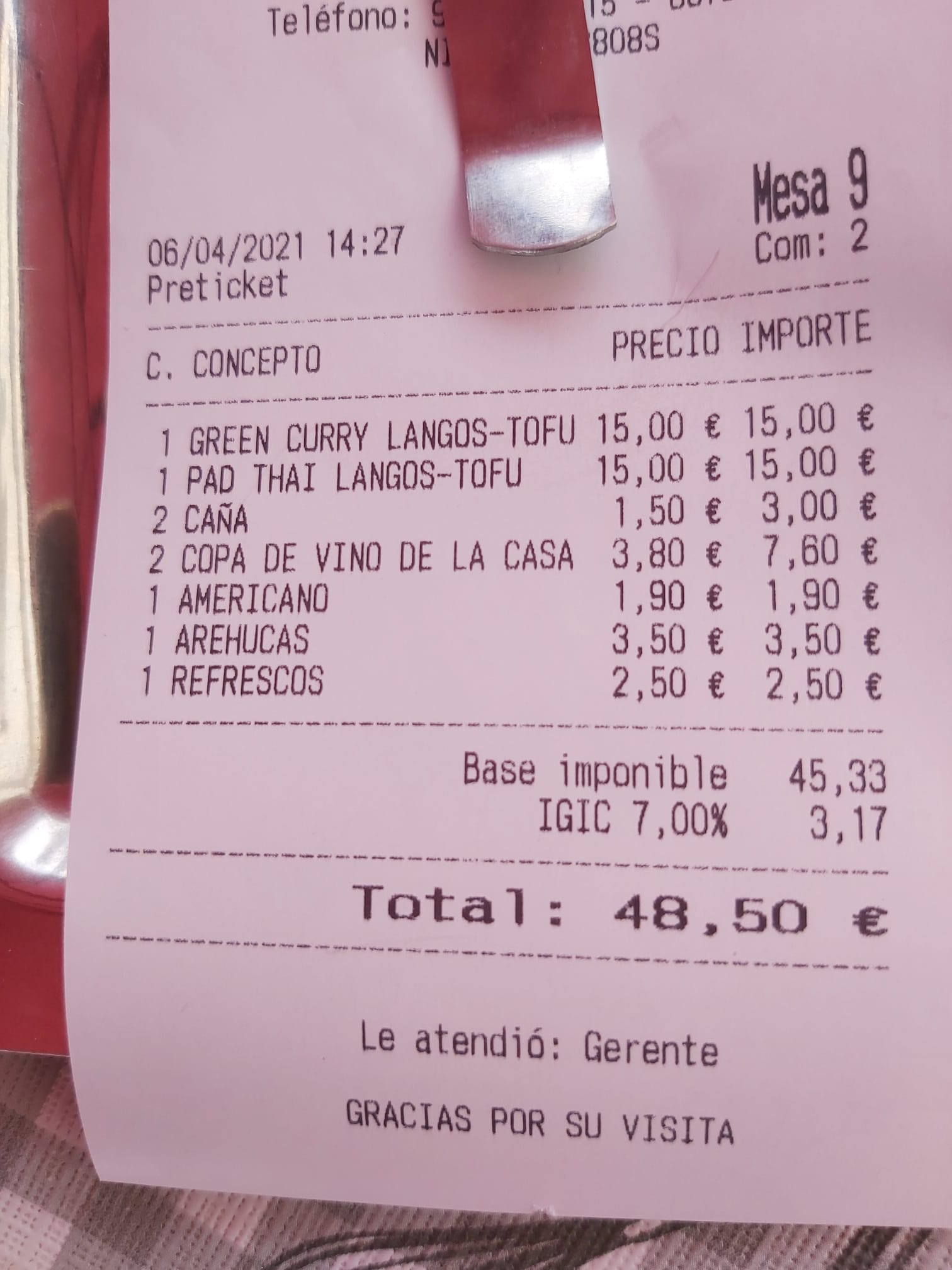
Bululú: Quality Fusion Restaurant That Really Understands Food
 Bululú, quite appropriately on the corner of Calle Venezuela and Olof Palme in Las Palmas, is a South American restaurant that looks towards the Caribbean and beyond for its inspiration.
Bululú, quite appropriately on the corner of Calle Venezuela and Olof Palme in Las Palmas, is a South American restaurant that looks towards the Caribbean and beyond for its inspiration.
Its food is a fascinating fusion of South American and Latin Caribbean ingredients and dishes with a healthy hint of Lebanese influence mixed in.
If that sounds like too much geography for one restaurant, don't worry: Bululú pulls it off. This is a restaurant that really understands food and specifically what makes Latin American food so delicious.
 It plates up an elevated mix of sweet, hot, rich and crispy in every dish. Pabellon criollo with crispy arepas and bananas fried to the point of caramelisation. A fatoush salad that is generous and moreish, hummus with marrow and curry, served with excellent falafels. For dessert, a rich quesillo with just the right amount of dulce de leche.
It plates up an elevated mix of sweet, hot, rich and crispy in every dish. Pabellon criollo with crispy arepas and bananas fried to the point of caramelisation. A fatoush salad that is generous and moreish, hummus with marrow and curry, served with excellent falafels. For dessert, a rich quesillo with just the right amount of dulce de leche.
The quality food comes with service to match. Friendly, efficient, always smiling, happy to advise. In fact, Bululú pretty much has this whole restaurant game nailed down.
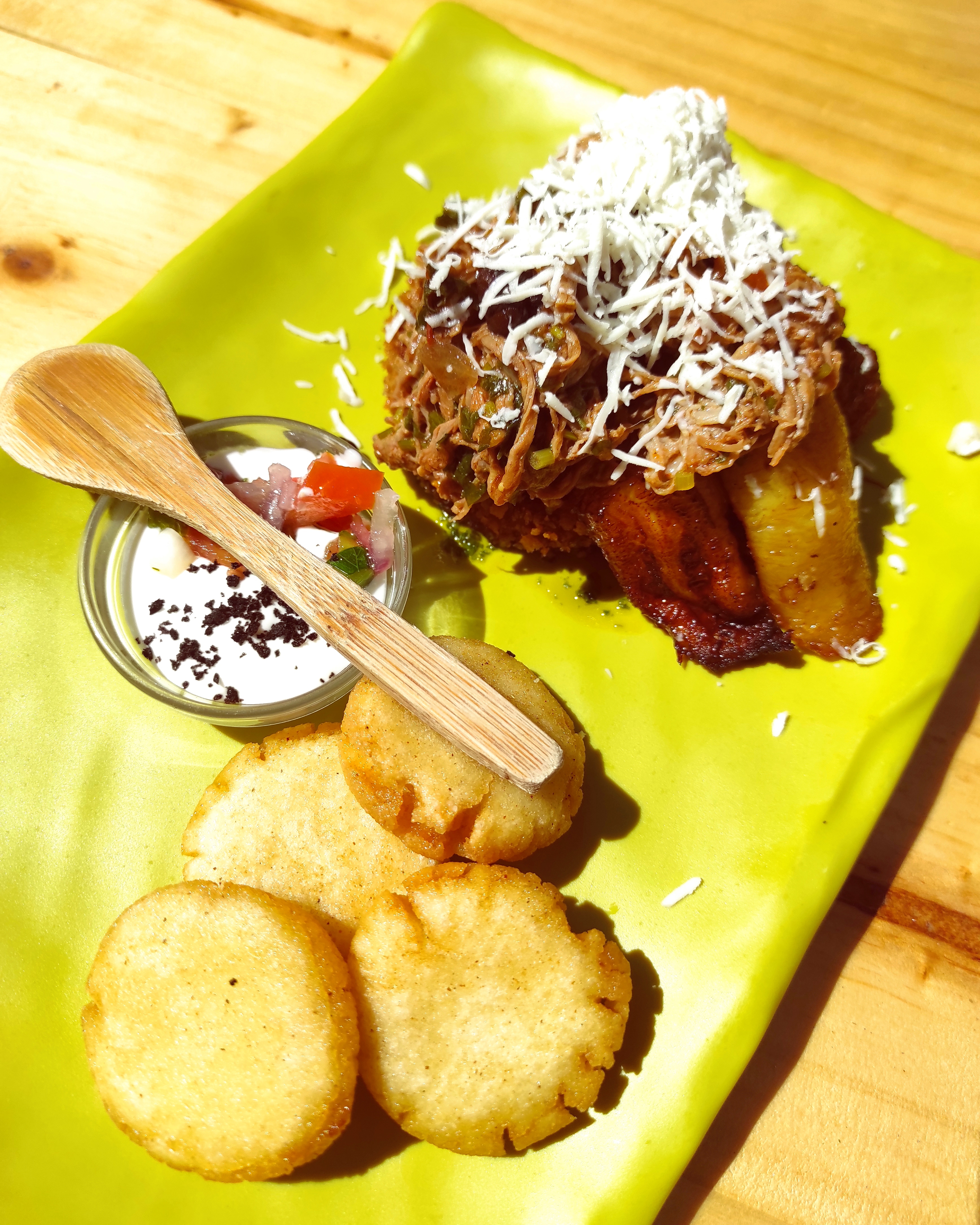 Great value and just the perfect spot for lunch in Guanarteme if you are bored of the tyranny of always having to sit on the beachfront.
Great value and just the perfect spot for lunch in Guanarteme if you are bored of the tyranny of always having to sit on the beachfront.
Book for a weekend table or arrive early for weekday lunchtime as Bululú has a loyal local crowd.
On Tripadvisor
Tel: 828 66 10 79
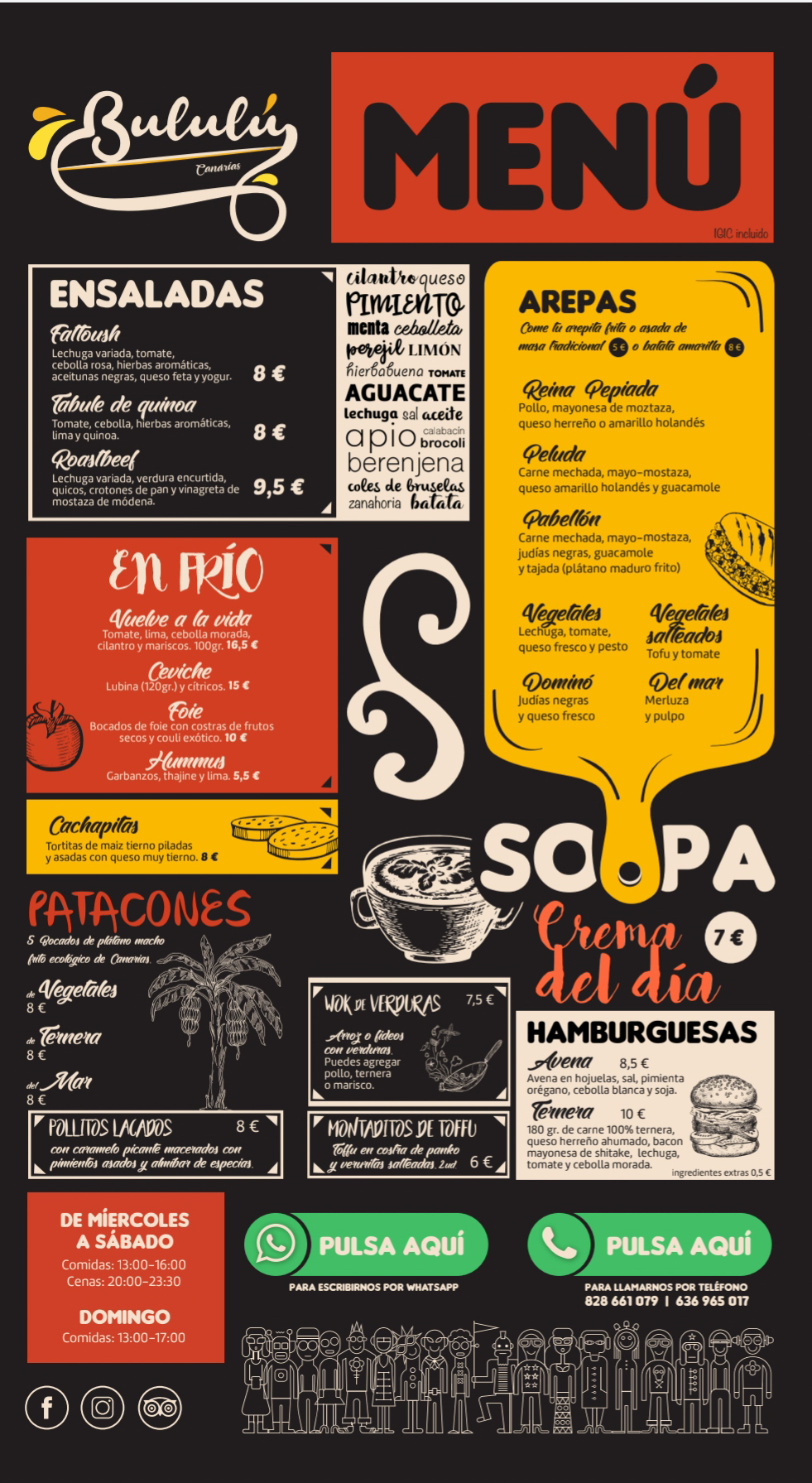

Blossom Art & Food Review
 We stopped at Blossom Art & Food for lunch just because it looked so pretty and most of the other stands at the food strip on the top floor of The Market wetren't open. The serfvice was frioendly and efficient and the food did look like a piece of art. Unfortunately, it tasted like one too.
We stopped at Blossom Art & Food for lunch just because it looked so pretty and most of the other stands at the food strip on the top floor of The Market wetren't open. The serfvice was frioendly and efficient and the food did look like a piece of art. Unfortunately, it tasted like one too.
It feels mean to give a restaurant a bad review during these times when just being open is an achievement. However, the freedom to be honest is one of the main reasons we decided to go down the route of member-only content.
Blossom Art & Food has a great location at the tip of The Market shoppping centre. All tables are outdoors and shaded by yellow canopies and umbrellas. It feels bright and airy and there is a good breeze.
The menu is international and the Thai dishes caught our eye straight away so we ordered the Thai salad followed by the Pad Thai. The salad looked great with a generous helping of prawns and bits of mango. The salad was a bit old and we had to fish out a couople of brown bits. And they seemed to have forgotten the dressing because it was dry. The prawns were fine although the batter could have been crispy rather than soft.
 The Pad Thai was of a smiliar quality with mushy spaghetti instead iof noodles and the sweet/ sour balance all wrong. It tasted like it was made by siomeone who had never eaten a real one.
The Pad Thai was of a smiliar quality with mushy spaghetti instead iof noodles and the sweet/ sour balance all wrong. It tasted like it was made by siomeone who had never eaten a real one.
Maybe we asked too much by ordering two Thai dishes at a restaurant that isn't a specialist but if they are on the menu, they should be good quality.

We'd go back for a sunset drink just just for the location but I don't think we'd eat here again.
Brunch By The Beach: Las Canteras' Best Spots
Breakfast by the beach has always been a bit of a challenge in Las Palmas. Most of the bars and restaurants along Las Canteras beachfront will do you an early cofffee but they really start with the lunch crowd.
However, things are looking up and several Las Canteras spots now do a decent breakfast and brunch. It must be all the Digital Nomads roaming the city demanding avocado on toast!
There are now several franchise bakeries doing passable coffee, pastries and cakes. However, the beachfront Starbucks is currently closed.
Old favourite: La Oliva
To be fair to La Oliva, it has been offering a good value breakfast for years. Its English breakfast is perfect except for the frankfurter. The service is efficient and you can't beat the location under the palm trees at the north end of Las Canteras. La Oliva is always a solid choice.
New and Improved: The Crunch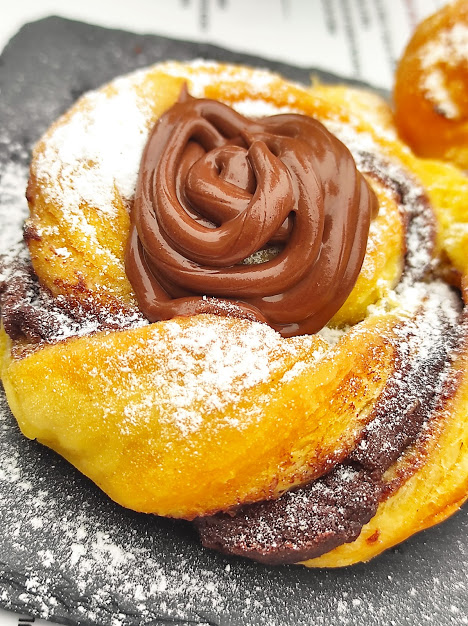
On the corner called Punta Brava where La Cicer ends, The Crunch (the former Cafe Mozart) now offers a range of breakfasts from scrambled eggs to pan am tomaquet. The place has been redecorated and combined with the clothes shop next door and a second Spanish tapas bar. All rather confusing and hipsterish but at least the toilet door signs are recognisable. The food is good, the service is slightly less grumpy than before and the double chocolate pastry twist (early birds only) is buttery and delicious.
Brunch masters: The Couple
Brunch at The Couple will set you back at least 12 euros each with coffee but its cooked breakfast and, yes, avocado on toast are worth the extra spend. The service is friendly, portions generous and if you are a two-course brunch kind of person, hit the crepes.
Other decent options on or close to the beach
Cafe Suecia on Thomas Miller; Redecorated but still has that lovely warm old-school Swedish feel; it now does proper espresso as well as Scandi-style filter coffee. You have to try the almond crossant.
La Quila on Playa Chica does a mean chocolate croissant and a decent eggs and bacon.
Finding The Lady of Bandama: A Unique Species
You have to up early and very lucky to find the Bandama Caldera full of mist like in Lex's photo. It only happens a few days every year and clears as soon as the sun starts to warm up.
However, there is a lot of stuff to see and do in and around the caldera other than drive to the top of the cinder cone and look at it. You can walk around it, down to the crater floor, visit the aboriginal caves, and the secret bunker (when the visitor centre reopens).
The Lady Of Bandama
A few days ago we walked down to the caldera floor to find something truly unique.
Parolinia glabriuscula, know as the Dama de Bandama or Bandama Lady, only grows inside the walls of the caldera. In fact, it only grows on the cliffs at the southeastern end of the caldera and on the scree at its base.
To be honest, the Dama isn't the most exciting plant in the world to look at. It's similar to other Parolinias growing in other places around the island (Guayadeque, the southern slopes of the island, etc).
What makes it special is that it is critically endangered and only grows in a tiny area: Definitely unique enough to walk across the Caldera floor to find; especially in January to March when it produces its little white flowers.
It seems to be thriving now that goats no longer graze inside the Caldera (and now the aggressive donkey has gone). There are far more plants than I remember when I was a kid and they have spread down the scree slope and almost onto the floor. Good news that is being repeated all over the island now that most goats are kepet bpenned in rather than roaming free.
ALEX SAYS: I was with my mother, a botanist, when she discovered the Dama de Bandama back in the 1980s. We were walking around the crater rim and spotted the only one growing outside the caldera.
Everything you need to know to walk down to the caldera floor is in our Gran Canaria map. We haven't marked the caves because we want to go back and make sure they are still safe to reach.
Note that the Hoyos de Bandama winery tends to have fairly erratic opening houtrs so if you see it open, head in for a glass of wine. The Caldera dry white is one of Gran Canaria's best.
Arinaga In The Sunshine
It's hard to explain how much Arinaga has improved in the last 25 years. From a windy and dusty little east coast town with a ramshackle seafront it has turned into a thoroughly pleasant place to spend a day. Or longer!
Here's a few of our favourite things to do in Arinaga...
Lunch at the Vaqueria de Las Salinas at the far southern tip of the beach
The Vaqueria specialises in pork dishes from the Canarian black pigs that the aboriginals brought with them to the islands over 200 years ago. However it also does a good range of local dishes if you don't fancy pork. Its one of the exceptions to the Gran Canaria restaurant rule that its best to eat fish by the sea and meat inland. Fair enough since it's set in an old cow shed next to what used to be the town's salt pans. It's worth eating here when you can just for the setting and the decor.
The Vaqueria hopes to reopen mid February (with outdoor tables in the car park) at Arinaga but the same people run La Cuchara, which is on the Carretera de Los Corralillos, Kilómetro 2 and is serving on its terrace.
Jump in off the old jetty
The stone jetty at the east end of Arinaga has been there for longer than most of the town and is a meetimg oint for the local kids who love jumping off the end.
It's a perfectly safe spot to jump into the sea even at low tide because thre water is deep and almost alwatys calm. The sea at Arinaga is as clear as it gets and a beautiful blue colour.
Take a snorkel because there are a lot fish around the jetty inclduing a big school of bright-blue damselfish or fulas. Also look out for orange starfish, and schools of parrotfish that swim around the fishermen on the jetty and feed close to the shore.
See our snorkelling guide to Gran Canaria.
Walk along the coast to the other old jetty
From the jetty at the end of the beach, follow the coastal promenade north and you reach the Soco Negro natural pool. Another of Arinaga's many fine swimming spots. Keep going, past the giant ceramic fish, and you reach the old lime kiln and the restaurant next to it at the end of the promenade. Keep going along the coast and you get to Muelle Viejo beach named after the old jetty at its north end. It's a good swimming spot on calm days and the Horno de Cal restaurant here is a local favourite.
Seafood on the seafront
Apart from La Vaqueria, all the restaurants along Arinaga beach serve seafood.
While it is windy all along the east coast duting the summer, the winter breeze is really no problem most days. And the
Guayadeque: Where Spring Starts In Gran Canaria
It's going to be a stunning year for walking (or driving) in Gran Canaria because this second rainy spell will extend the green into April and May. The rain this week was what local farmers call "lluvia mansa" or tame rain; gentle rain over a long period that really soaks into the soil rather than crashing down and running off into the sea.
We went to Guayadeque this weekend in search pf the first flowers of spring because it's low down and always one the first areas to explode into colour. However, it turns out we timed our visit wrong. We arrived after the almond blossom and a couple of weeks of sunshine before the wildflowers. The valley is all bright green but apart from the purple lavendar and white echiums, there were just a few almonds tucked into shady corners still covered in flowers.
We'll be back once it is full bloom and full of bees to get some photos for anyone who cant make it there this year.
On this visit we drove all the way up the road to the cave restaurants at the top (the museum at the bottom of the valley is currently closed). There's an easy loop walk around the back of the famous Tagoror cave restaurant. It's only 500 metres but you get great views down the valley and it even has a cave gift shop full of local arts and crafts and Guayadeque honey.
Then we did a few kilometres of the trail that runs from the cave restaurants up towards the Caldera de Los Marteles or towards Cazadores. It's a wide path but quite steep at the beginning and you get more views of the whole valley stretching out towards the sea.
The restaurants and bars in Guayadeque, including the famous Tagoror cave restaurant, are open but with outdoor tables only so they fills up fast at the weekends.
Guayadeque: From cave fortress to late night leaf dancing
The Guayadeque Ravine was one Gran Canaria's aboriginal strongholds. It's rugged walls and many caves allowed them to thrive here out of reach of European and North African pirates and slave raiders. They even used moveable ladders to make their cave villages impregable. It's all explained in the museum at the bottom of the ravine but it is currently closed due to structural problems (the roof cracked).
The tradition of cave living continues today although the population of Guayadeque is dropping as the last few farmers and shepherds retire. There used to be farms in the valley that were completely troglodyte with cattle, sheep and goats, chickens and rabbits all in their own caves. Until the early 1990s part of the valley still had a stream overgrown with vast taro plants or ñames. The farmer who owned the rights to the water refused to let it be piped until he died.
Maybe he was old enough to remember a famous tradition that only seems to have happened at Guayadeque; the dance of the leaves. In the old days, young men and women would gather around a fire once the priest had gone to sleep and dance naked for each other using ñame leaves to preserve their modesty.
Tried And Tasted Ruiz de Alda Restaurant Tips From Alex
Parallel to Mesa y Lopez, the pedestrian Ruiz de Alda has become a firm favourite as a lunch spot for Las Palmas locals.
It's always busy but most places have a free table even at peak times. As always, if you want a guaranteed spot, turn up early at 13.00 on the dot before the locals finish the morning shift and head out to lunch.
We've tried many of the restaurants and so far the general quality and value is good. Here are my top recomendations at the moment...
Mr Kale at the west end is always a good bet for poke bowls and wok dishes, especially if you get the 2-for-1 main course offer from its Facebook page.
Pinxe Tacos at the far west end of the street does a small but well-curated selection of tacos, sopes and nachos. Excellent for a light lunch at its outdoor tables but there isn't enough on the menu for a substantial meal.
For a big menu del dia with three courses, drink and coffee (12 euros) head to La Tasca de Lua about half way along the street. Modern Spanish food with sold Asian-inspired dishes depending on the day. The Thai beef rice I had last time I was here didn't look like much but was delicious.
If you just fancy a burger, the 200 Gramos half way down the street is always a solid option but remember to ask for yours "bien hecho" as the default way to serve burgers in Gran Canaria is pink inside.
Llevame al Huerto is the spot for vegetarian although the restaurant is actually more flexitarian with some seafood and dairy options.Everything is fresh, well-presented and tasty.
White Flower Walk In Las Palmas' Only Wild Valley
 Late January and early February is the perfect time to explore Las Palmas' only remaining wild valley; The Guiniguada Barranco. It's when it's at it greenest and the white echium bushes are in full flower.
Late January and early February is the perfect time to explore Las Palmas' only remaining wild valley; The Guiniguada Barranco. It's when it's at it greenest and the white echium bushes are in full flower.
It's an easy walk between Triana and Santa Brigida past the Jardín Canario botanical garden. The path has recently been widened so you can now walk or mountain bike all the way to Santa Brigida town without having to scamble over the barranco floor.
From the start of the trail by Triana, it is 8.8km to the Maipez bar just below the Jardín Canario. From here you swap into the Barranco de Santa Brigida and a further three kilomtres takes you past La Calzada village to arched bridge popular with bungee jumpers. The trail continues for 5km up the wide valley floor all the way to Santa Brigida past Angostura and Las Meleguinas villages.
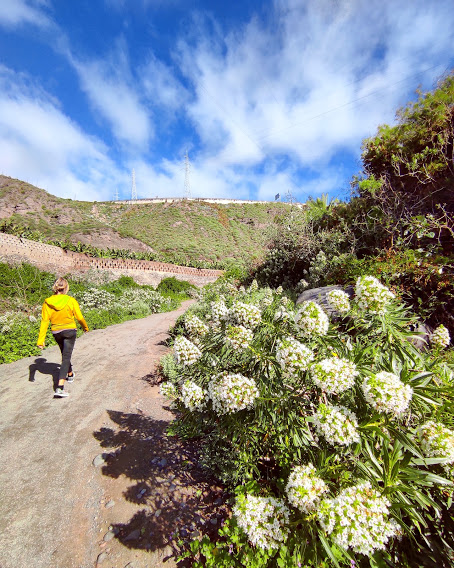 The lower part of the trail goes past banana plantations before the valley gets wilder and you leave the ridgetop houses of Las Palmas behind. The top half is greener and narrower with more banana plantations and some big houses. Between the Maipez and the Angostura bridge the barranco is narrow and steeper while the ñast part is a is a mix of fruit orchards, farms and palm groves.
The lower part of the trail goes past banana plantations before the valley gets wilder and you leave the ridgetop houses of Las Palmas behind. The top half is greener and narrower with more banana plantations and some big houses. Between the Maipez and the Angostura bridge the barranco is narrow and steeper while the ñast part is a is a mix of fruit orchards, farms and palm groves.
There are no shops or toilet facilities along the way so take plenty of water and snacks. The trail is wide and not steep although bits of it are cobbled and awkward on a bicycle. The top half of the walk has several picnic sites with shade and benches.
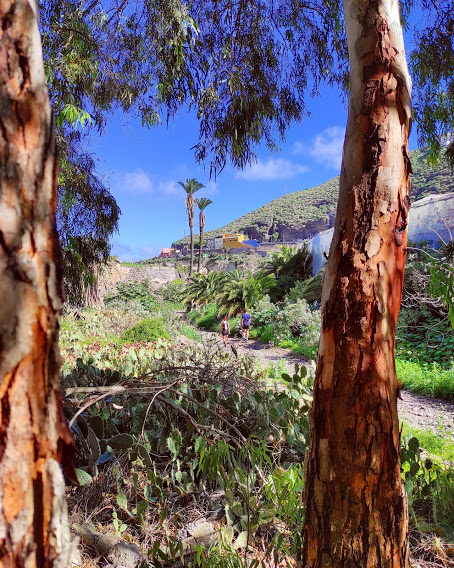 Normally, you can keep walking along the roadside to the bottom entrance of the Jardín Canario, then up through the garden to the bus stop for a ride back down to Las Palmas. However, the JC is only open via the top entrance at the moment betwenn 09.00 and 14.00.
Normally, you can keep walking along the roadside to the bottom entrance of the Jardín Canario, then up through the garden to the bus stop for a ride back down to Las Palmas. However, the JC is only open via the top entrance at the moment betwenn 09.00 and 14.00.
If you want to stop walking at the Maipez (9km from Triana) the best option is to call a taxi (less than 10 euros back to the city). The Maipez itself is still open although you aren't allowed inside at the moment. Its devilled eggs (huevos rellenos) are a good snack after a long walk.
The best radio taxi service in the area is TARA: 928 460 000
Nature Notes
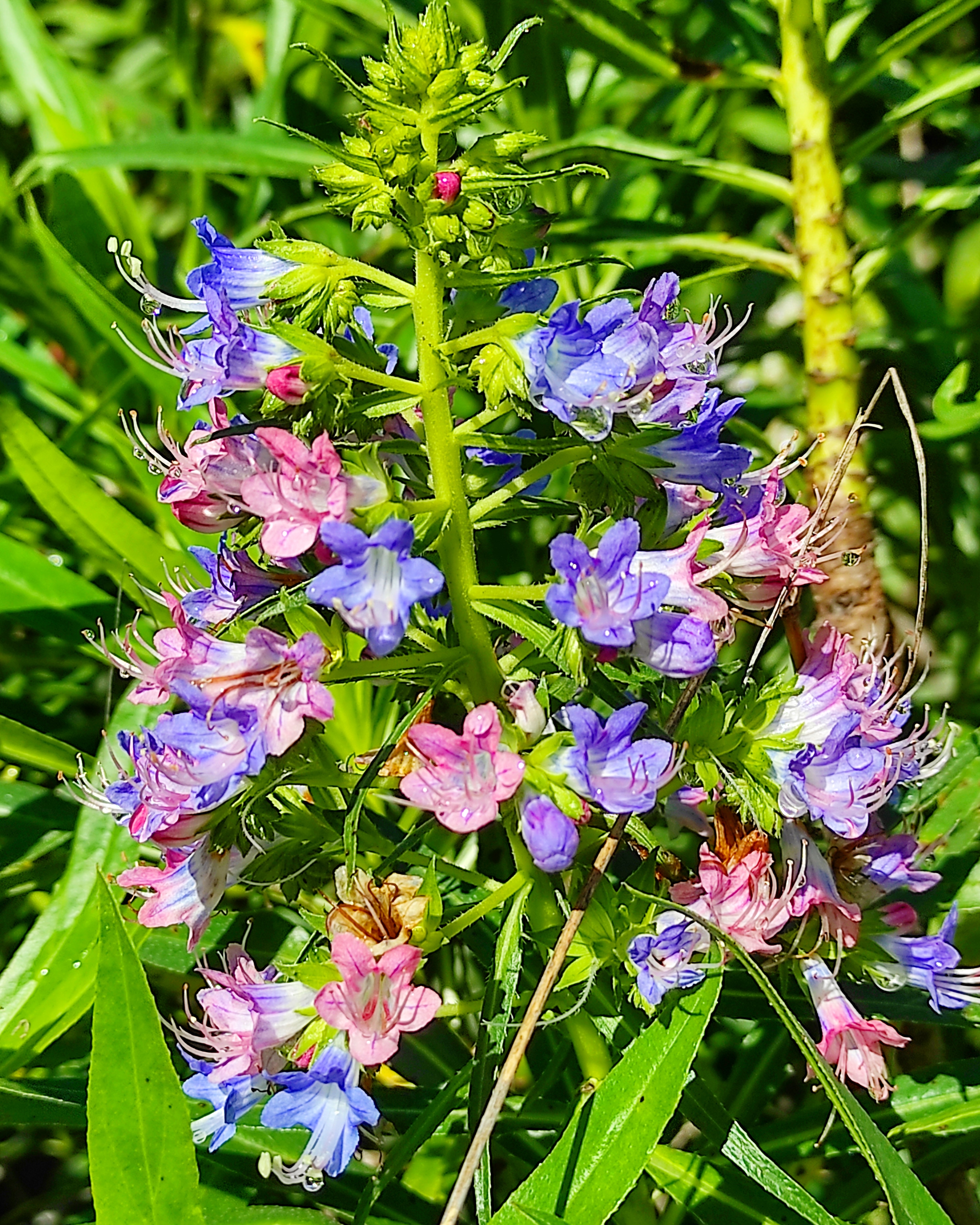 Every January the Guiniguada Valley explodes into colour as the white echiums flower alongside daisies and nasturtiums.
Every January the Guiniguada Valley explodes into colour as the white echiums flower alongside daisies and nasturtiums.
The echiums in the Guiniguada are Echium decasnei with white flowers but you do get the odd blue plant as well (see photo right). In the lower part of the Guayadeque Valley many of the E. decasnei have blue flowers.
The palm trees in the lower part of the valley are nesting sites for ring-necked parakeets and there are pairs of kestrels all along the trail; we saw two mobbing a buzzard. Gran Canaria blue tits, chiffchaffs and Berthelot's pipits (running along the ground) are common.
Gran Canaria Info recommends:
- Default
- Title
- Date
- Random










